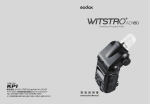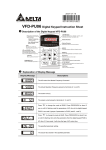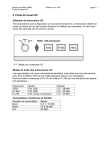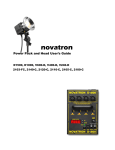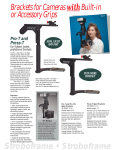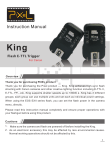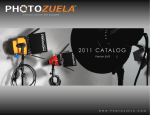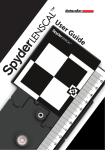Download Full review - Lighting Rumours
Transcript
PIXEL MAGO Canon version test report (sn 310105000068 firmware E7A 003) Material used for test Canon DSLR bodies : 5DMKII, 5D Canon flash : 580EXII Canon ST-E2 speedlite transmitter Sekonic L-358 flashmeter PixelKingPro wireless transmitters Westcott Apollo softbox ------------------------------------------------------------------------------------------------------------------User background professional photographer Using Canon DSLR since 2001 (Canon D30,10D,1D,1DMKII,5D,40D,5DMKII,5DMKIII) web sites : http://www.eventtography.com http://www.happygraphy.com -----------------------------------------------------------------------------------------------------------------Findings (developed later) GN equivalent as Canon 580EXII at 24 and 105 mm zoom position, lower by 2/3 stops at 50mm position External power supply not compatible with Quantum Instruments Canon battery cables Incompatibility with Canon STE2 wireless transmitter Stroboscopic mode mentions up to 500 times on intro page 4 while LED menu provides 100x at 1Hz to 30x at 500 Hz (same as manual page 7) No info for cable and external power supply part numbers in user manual ---------------------------------------------------------------------------------------------------------------------Test Protocol Unpacking/User guide reading Specifications and basic functions test Stress test Optical master/slave function test with Canon 580EXII and Canon STE2 LED function test with Pixel King Pro / Apollo soft box Tests results 1) Unpacking/User guide The flash is delivered in a quality packaging and bundled with a proper bag ,stand and light diffuser cap (stofen type), but no color gels . Build quality and basic specifications are on par with Canon 580 EXII flash . The feeling of a quality product is right there, with good finish, a metal flash foot with dust/water protection similar to Canon flash . The user guide manual is thorough and easy to read, a nice improvement over the Pixel King Pro user manual with very small characters and succint explanation . Most functions on the flash are self explanatory and do not even need the user manual, apart perhaps for the wireless function which requires the wireless button to be pushed 1 second in order to activate the function. The flash is equipped with a lock position. The lcd display is very readable and the duration it is lit can be customized in order to preserve the batteries . 2) Specifications/basic functions test As stated above, the flash main features are similar to Canon high end 580EXII. It has notably : – – – – – – – – – – ETTL II support optical infrared wireless (4 channels/3 groups) manual flash from 1/1 to 1/128 in 1/3 stops increment 1st and second curtain sync, HSS sync external power supply socket * metal foot +dust/water cover protection horizontal swivel 180° both directions overheat protection circuit pc sync port – and has some features that exceed it, notably : – – – – zoom coverage 20-200 mm + 14mm vs Canon 580EXII 24-105 mm coverage flash firmware can be upgraded via usb (located in battery housing) most outstanding feature is the modeling light function (developed later) . Very good ergonomy/ user interface, much better than Canon 580EXII . The excellent user manual is almost not necessary to activate all flash functions very good recycling time at full power ( we measured 3 seconds, user manual states 4 seconds) – * external power supply :we could not actually test since it uses different cables than the Quantum Instruments cables that we use for our Quantum Turbo external batteries on a Canon 580 EXII european version. 3)POWER / Guide Number : The flash power was tested at 1/1 full power with a Sekonic L-358 flashmeter . At 24 and 105 , Mago GN is equivalent at Canon 580EXII, while at 50mm zoom position, we recorded a 2/3 stops difference (less) vs Canon 580EXII. Stress test I used fresh rechargeable batteries for the stress test, since we could not use our Quantum batteries as the cables we have are not compatible with the Mago power socket . I set the flash at full power and activated it each time after full recycling (3 seconds vs 4 seconds mentioned in user manual) . It took almost 4 minutes / 80 full power flashes before the « Warning: Batter temperature » message appeared on the lcd and put the flash in standby . It took then about 10 minutes before the message disappeared and the flash could be used again . For photojournalists, availability of the flash in all circumstances is critical and I am looking forward being able to test the flash with an external battery to assess this further . Canon flashes have a very conservative approach to overheating and the standby mode is triggered very fast, causing the flash to be unavailable . Nissin has tried to approach this issue with their Extreme flash so that I am curious to see how good the Mago rates on this. When working on assignments such as weddings,... I almost always use lateral bounce light wich requires usage of the flash at 1/2 or full power. Therefore I always pair the flash with external batteries such as Quantum Turbos, Godox PB960,... As soon as I will know which cable reference to buy, I will test the flash on a wedding assignment . 4) Canon equipment compatibility The flash has been tested with the following Canon equipment : Canon 5D MKII and Canon 5D (classic) dslrs Canon 580 EXII flash Canon ST-E2 wireless transmitter The flash has been found fully compatible with Canon 5DMKII Flash External Menu function:the flash settings can be modified from the Canon body itself , with the limitations Canon has set (for instance zoom range is limited to Canon 580EXII flashes zoom range 24-105 on the 5DMKII, and the EV can be +- 2.00 vs Mago +- 3.00 capability ). Infrared Wireless Master/Slave compatibility : The flash has been found fully compatible with Canon 580 EXII flash on a Canon 5DMKII body in multiple Master/Slave scenarios !!!!!!!!!!!!!!!!!!!!!!!!!!!!!!!!!!!!!!!!!!!!!!!!!!!!!!!!!!!!!!!!!!!!!!!!!!!!!!!!!!!!!!!!!!!!!!!!!!!!!!!!!!!!!!!!!!!! When using a Canon ST-E2 wireless transmitter as Master on Canon bodies (both 5DMKII and 5D), the Mago fired but out of sync so that no flash exposure was recorded . I repeated the test with two STE2s , same results while Canon 580EXII would sync OK . I checked Pixel web site for a firmware upgrade but did not see any available for the Mago. !!!!!!!!!!!!!!!!!!!!!!!!!!!!!!!!!!!!!!!!!!!!!!!!!!!!!!!!!!!!!!!!!!!!!!!!!!!!!!!!!!!!!!!!!!!!!!!!!!!!!!!!!!!!!!!!!!! 5) Special functions/LED modeling light The function that sets the Mago apart from other speedlights is its integrated led modeling lights (2 leds behind a removable diffuser) which allows the user to assess the direction/quality of light produced prior to flash exposure . Pixel literature insists on the led main function to assist autofocus in video / low light environment, but to me I see it mainly as the way to assess my light positioning when working in photo studio environment. This has always been an issue with Speedlights vs studio strobes which have an integrated modeling light. This is a definite plus that the Mago provides over the competition . I have tested the Mago in a studio environment with Pixel King Pro wireless transmitters and a Westcott Apollo softbox in which the Mago was housed . In a studio environment with muted/low ambient light, the Mago led is powerful enough (can be improved to let the photographer assess the light's effect through the softbox (see 3 images appended) This will probably not be the case in highly lit environments, but this restriction is valid for studio strobes modeling lights as well . Led modeling lights restrictions : The user manual states clearly that the modeling light cannot be used for along time ; so that it should be used to assess the light effect and then turned off . Also worth noting that all flash functions/settings are deactivated when the led is turned on . As expected, the PixelKing Pro are fully compatible with the Mago so that the flash output could be set from the King transmitter without having to remove the flash from the softbox . One very welcome addition would be the ability to turn the led flash on/off from the Pixel King Pro transmitter . I hope that Pixel will integrate this in a newer firmware version if possible and/or in the next generations of wireless transmitter/receivers . 6)CONCLUSION The Mago is a very solid offering on the market, and while unknown to me, I expect the price/quality ratio to be of high value for customers looking for a full featured speedlight, with a unique modeling light offering . As stated previously, ability to turn the modeling light on/off from the Pixel King transmitters would be a definite plus as it would allow the photographer to perform all operations from the camera standpoint and for instance not to have to open a softbox in which the Mago is located to use the modeling light . Being a speedlight , the Mago does not compete with studio strobes or more powerful flashes like Quantum or Godox Witstro, but with its modeling light that allows to pre-visualize where the light will hit, I see it as a very attractive part of my portable studio set as a hairlight for instance . As a speedlight, it is 100% competitive with high end optical wireless speedlights as Canon 580EXII, at a fraction of the cost I suspect. Other minor area of concern is full compatibility with Canon STE2 wireless transmitter, and compatibility of the external power supply socket with other brands cables . Congrats to Pixel for this new product and many thanks for letting me test it . Test summary Packaging 5/5 Accessories 4/5 (no gels included) Finish 5/5 Basic specs 4/5 (power socket compatibility) Canon compatibility 4/5 (canon ste2 issues) Special Functions 5/5 (led modeling light)





